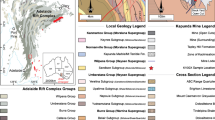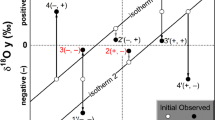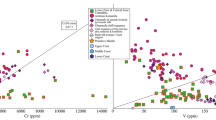Abstract
Based on the analysis of coexisting minerals (magnetite, ilmenite, titanite, and pyroxene), the temperature and redox conditions of rock crystallization in the Khibina alkaline massif were estimated. Under the redox conditions typical of the Khibina complex, the carbon speciation evolved as follows: CO2 in fluid and carbonate anions in melt at high temperatures; then, graphite formation; and, at lower temperatures, the appearance of significant amounts of hydrocarbons owing to fluid-graphite interaction. Abiogenic hydrocarbons in magmatic complexes can be produced by processes differing from the Fischer-Tropsch synthesis.
Similar content being viewed by others
References
E. F. Osborn, “Role of Oxygen Pressure in the Crystallization and Differentiation of Basaltic Magma,” Am. J. Sci. 257, 609–647 (1959).
D. C. Presnall, “The Join Forsterite-Diopside-Iron Oxide and Its Bearing on the Crystallization of Basaltic and Ultramafic Magmas,” Am. J. Sci. 264, 753–809 (1966).
D. Canil, “Vanadium Partitioning and the Oxidation State of Archean Komatiite Magmas,” Nature 389, 842–845 (1997).
D. Canil, “Vanadium Partitioning between Orthopyroxene, Spinel and Silicate Melt and the Redox States of Mantle Source Regions for Primary Magmas,” Geochim. Cosmochim. Acta 63, 557–572 (1999).
D. Canil, “Vanadium in Peridotites, Mantle Redox and Tectonic Environments: Archean to Present,” Earth Planet. Sci. Lett. 195, 75–90 (2002).
D. H. Green, T. J. Fallon, and W. R. Taylor, “Mantle-Derived Magmas-Role of Variable Source Peridotite and Variable C-O-H Fluid Compositions,” in Magmatic Processes: Physicochemical Principles, Ed. by B. O. Mysen, Geochem. Soc. Spec. Publ. 1, 139–154 (1987).
I. A. Petersilie, “Hydrocarbon Gases and Bitumen from the Intrusive Massifs of the Central Part of the Kola Peninsula,” Dokl. Akad. Nauk SSSR 122, 1086–1089 (1958).
I. A. Petersilie and H. Sørensen, “Hydrocarbon Gases and Bituminous Substances in Rocks from the Ilímaussaq Alkaline Intrusion, South Greenland,” Lithos 3, 59–76 (1970).
S. V. Ikorsky and N. A. Shugurova, “New Data on the Composition of Gases in Minerals from the Alkaline Rocks of the Khibina Massif,” Geokhimiya, 953-947 (1974).
L. N. Kogarko, Problems of the Genesis of Agpaitic Magmas (Nauka, Moscow, 1977) [in Russian].
L. N. Kogarko, C. Kosztolanyi, and I. D. Ryabchikov, “Geochemistry of Reduced Fluid in Alkali Magmas,” Geochem. Int. 24, 20–27 (1987).
L. N. Kogarko, C. Kosztolanyi, and I. D. Ryabchikov, “Geochemistry of Reduced Fluid of Alkali Magmas,” Geokhimiya, 1688–1695 (1986).
G. Markl, M. Marks, G. Schwinn, and H. Sommer, “Phase Equilibrium Constraints on Intensive Crystallization Parameters of the Ilímaussaq Complex, South Greenland,” J. Petrol. 42, 2231–2257 (2001).
V. A. Nivin, “Gas Concentrations in Minerals with Reference to the Problem of the Genesis of Hydrocarbon Gases in Rocks of the Khibiny and Lovozero Massifs,” Geochem. Int. 40, 883–898 (2002).
V. A. Nivin, P. J. Treloar, N. G. Konopleva, and S. V. Ikorsky, “A Review of the Occurrence, Form and Origin of C-Bearing Species in the Khibiny Alkaline Igneous Complex, Kola Peninsula, NW Russia,” Lithos 85, 93–112 (2005).
J. Potter, A. H. Rankin, and P. J. Treloar, “Abiogenic Fischer-Tropsch Synthesis of Hydrocarbons in Alkaline Igneous Rocks; Fluid Inclusion, Textural and Isotopic Evidence from the Lovozero Complex, N.W. Russia,” Lithos 75, 311–330 (2004).
B. Beeskow, P. J. Treloar, A. H. Rankin, et al., “A Reassessment of Models for Hydrocarbon Generation in the Khibiny Nepheline Syenite Complex, Kola Peninsula, Russia,” Lithos 91, 1–18 (2006).
L. N. Kogarko, Genetic Problems of Agpaitic Magmas (Nauka, Moscow, 1977) [in Russian].
S. Salvi and A. Williams-Jones, “Alteration, HFSE Mineralisation, and Hydrocarbon Formation in Peralkaline Igneous Systems: Insights from the Strange Lake Pluton, Canada,” Lithos 91, (2006).
I. A. Petersilie, “Hydrocarbon Gases and Bitumen in the Intrusive Massifs from the Central Part of the Kola Peninsula,” Dokl. Akad. Nauk SSSR 122, 1086–1089 (1958).
S. V. Ikorskii and N. A. Shugurova, “New Data on Gas Composition in Minerals from the Alkaline Rocks of the Khibiny Massif,” Geokhimiya, 943–947 (1974).
A. F. Buddington and D. H. Lindsley, “Iron-Titanium Oxide Minerals and Synthetic Equivalents,” J. Petrol. 5, 310–357 (1964).
R. O. Sack and M. S. Ghiorso, “An Internally Consistent Model for the Thermodynamic Properties of Fe-Mg-Titanomagnetite-Aluminate Spinels,” Contrib. Mineral. Petrol. 106, 474–505 (1991).
M. S. Ghiorso and R. O. Sack, “Fe-Ti Oxide Geothermometry: Thermodynamic Formulation and the Estimation of Intensive Parameters in Silicic Magmas,” Contrib. Mineral. Petrol. 108, 485–510 (1991).
B. R. Frost and D. H. Lindsley, “Fe-Ti Oxide Geothermometry: Thermodynamic Formulation and the Estimation of Intensive Parameters in Silicic Magmas,” Contrib. Mineral. Petrol. 108, 485–510 (1991).
B. R. Frost, D. H. Lindsley, and D. J. Andersen, “Fe-Ti Oxide-Silicate Equilibria: Assemblages with Fayalitic Olivine,” Am. Mineral. 73, 727–740 (1988).
D. R. Wones, “Significance of the Assemblage Titanite + Magnetite + Quartz in Granitic Rocks,” Am. Mineral. 74, 744–749 (1989).
D. Xirouchakis and D. H. Lindsley, “Equilibria among Titanite, Hedenbergite, Fayalite, Quartz, Ilmenite, and Magnetite: Experiments and Internally Consistent Thermodynamic Data for Titanite,” Am. Mineral. 83, 712–725 (1998).
D. Xirouchakis, D. H. Lindsley, and D. J. Andersen, “Assemblages with Titanite (CaTiOSiO4), Ca-Mg-Fe Olivine and Pyroxenes, Fe-Mg-Ti Oxides, and Quartz: Part I. Theory,” Am. Mineral. 86, 247–253 (2001).
D. Xirouchakis, D. H. Lindsley, and B. R. Frost, “Assemblages with Titanite (CaTiOSiO4), Ca-Mg-Fe Olivine and Pyroxenes, Fe-Mg-Ti Oxides, and Quartz: Part II. Application,” Am. Mineral. 86, 254–264 (2001).
I. D. Ryabchikov, A. V. Ukhanov, and T. Ishii, “Redox Equilibria in Upper Mantle Ultrabasites in the Yakutia Kimberlite Province,” Geochem. Int. 23, 38–50 (1986).
H. S. C. O’Neill and V. J. Wall, “The Olivine-Spinel Oxygen Geobarometer, the Nickel Precipitation Curve and the Oxygen Fugacity of the Upper Mantle,” J. Petrol. 28, 1169–1192 (1987).
C. Ballhaus, R. F. Berry, and D. H. Green, “Oxygen Fugacity Controls in the Earth’s Upper Mantle,” Nature 348, 437–440 (1990).
C. Ballhaus, “Redox States of Lithospheric and Asthenospheric Upper Mantle,” Contrib. Mineral. Petrol. 114, 341–348 (1993).
B. J. Wood, L. T. Bryndzya, and K. E. Johnson, “Mantle Oxidation State and Its Relationship to Tectonic Environment and Fluid Speciation,” Science 248, 337–345 (1990).
I. D. Ryabchikov, A. V. Ukhanov, and T. Ishii, “Redox Equilibria in the Alkali Rocks from the Upper Mantle of the Yakutian Kimberlite Province,” Geokhimiya, 1110–1123 (1985).
I. D. Ryabchikov and L. N. Kogarko, “Redox Equilibria in Alkaline Lavas from Trinidade Island, Brazil,” Int. Geol. Rev. 36, 173–183 (1994).
I. D. Ryabchikov, I. P. Solovova, L. N. Kogarko, et al., “Thermodynamic Parameters of Generation of Meymechites and Alkaline Picrites in the Maymecha-Kotui Province: Evidence from Melt Inclusions,” Geokhimiya, No. 11, 1139–1150 (2002) [Geochem. Int. 40, 1031–1041 (2002)].
A. V. Sobolev, V. S. Kamenetsky, and N. N. Kononkova, “New Data on the Petrology of Siberian Meymechites,” Geokhimiya, 1084–1095 (1991).
R. Halama, T. Vennemann, W. Siebel, and G. Markl, “The Gronnedal-Ika Carbonatite-Syenite Complex, South Greenland: Carbonatite Formation by Liquid Immiscibility,” J. Petrol. 46, 191–217 (2005).
U. Mann, M. Marks, and G. Markl, “Influence of Oxygen Fugacity on Mineral Compositions in Peralkaline Melts: The Katzenbuckel Volcano, Southwest Germany,” Lithos 91, 262–285 (2006).
M. Marks and G. Markl, “Fractionation and Assimilation Processes in the Alkaline Augite Syenite Unit of the Ilímaussaq Intrusion, South Greenland, As Deduced from Phase Equilibria,” J. Petrol. 42, 1947–1969 (2001).
M. A. W. Marks, J. Schilling, I. M. Coulson, et al., “The Alkaline-Peralkaline Tamazeght Complex, High Atlas Mountains, Morocco: Mineral Chemistry and Petrological Constraints for Derivation from a Compositionally Heterogeneous Mantle Source,” J. Petrol. 49, 1097–1131 (2008).
E. E. Kostyleva-Labuntsova, B. E. Borutskii, M. N. Sokolova, Z. V. Shlyukova, M D. Dorfman, O. B. Dudkin, L. V. Kozyreva, and S. V. Ikorskii, Mineralogy of the Khibiny Massif. Minerals (Nauka, Moscow, 1978) [in Russian].
B. E. Borutskii, Rock-Forming Minerals of High-Alkali Complexes (Nauka, Moscow, 1988) [in Russian].
L. L. Perchuk, K. K. Podlesskii, and L. Y. Aranovich, Thermodynamics of Some Framework Silicates and Their Equilibria: Application to Geothermobarometry, in Progress in Metamorphic and Magmatic Petrology, Ed. by L. L. Perchuk (Cambridge University Press, Cambridge, 1991), pp. 131–164.
T. J. B. Holland and R. Powell, “An Internally Consistent Thermodynamic Data Set for Phases of Petrological Interest,” J. Metamorph. Geol. 16, 309–343 (1998).
T. J. B. Holland, “Activities of Components in Omphacitic Solid Solutions. Application of Landau Theory to Mixtures,” Contrib. Mineral. Petrol. 105, 446–453 (1990).
A. L. Perchuk and L. Y. Aranovich, “Thermodynamics of the Jadeite-Diopside-Hedenbergite Solid-Solution Model,” Geokhimiya, 539–547 (1991).
V. L. Vinograd, “Thermodynamics of Mixing and Ordering in the Diopside-Jadeite System: I. A CVM Model,” Mineral. Mag. 66, 513–536 (2002).
A. L. Perchuk and L. Ya. Aranovich, “Thermodynamic Model of the Jadeite-Diopside-Hedenbergite Solid Solution,” Geokhimiya, 539–547 (1991).
M. S. Ghiorso and R. O. Sack, “Thermochemistry of the Oxide Minerals,” in Oxide Minerals: Petrologic and Magnetic Significance, Ed. by D. H. Lindsley, Rev. Mineral. 25, (Mineral. Soc. Am., Washington, 1991), pp. 221–264.
T. Holland and R. Powell, “A Compensated-Redlich-Kwong (CORK) Equation for Volumes and Fugacities of CO2 and H2O in the Range 1 Bar to 50 Kbar and 100–1600°C,” Contrib. Mineral. Petrol. 109, 265–273 (1991).
K. I. Shmulovich, Carbon Dioxide in High-Temperature Mineral Formation (Nauka, Moscow, 1988) [in Russian].
C. Zhang, Z. Duan, and Z. Zhang, “Molecular Dynamics Simulation of the CH4 and CH4-H2O Systems up to 10 GPa and 2573 K,” Geochim. Cosmochim. Acta 71, 2036–2055 (2007).
I. D. Ryabchikov, Thermodynamic Analysis of Trace Element Behavior during the Crystallization of Silicate Melts (Nauka, Moscow, 1965) [in Russian].
Author information
Authors and Affiliations
Corresponding author
Additional information
Original Russian Text © I.D. Ryabchikov, L.N. Kogarko, 2009, published in Geokhimiya, 2009, No. 12, pp. 1235–1248.
Rights and permissions
About this article
Cite this article
Ryabchikov, I.D., Kogarko, L.N. Oxygen fugacity in the apatite-bearing intrusion of the Khibina complex. Geochem. Int. 47, 1157–1169 (2009). https://doi.org/10.1134/S0016702909120015
Received:
Published:
Issue Date:
DOI: https://doi.org/10.1134/S0016702909120015




